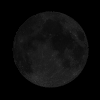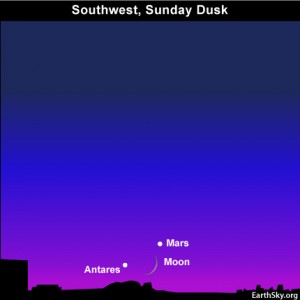Courtesy of EarthSky
A Clear Voice for Science
www.EarthSky.org [1]
Bright object in the southeast on November evenings? It’s the planet Jupiter [2]
 [3]
[3] [4]Will you catch the young moon slip in and out of the twilight dusk after sunset tonight?
[4]Will you catch the young moon slip in and out of the twilight dusk after sunset tonight?
You might, if you live at mid-northern latitudes or farther south in North America. At mid-northern latitudes in Europe and Asia, you will have to wait until after sunset Monday. However, all latitudes south of the equator have a decent chance of spotting the young waxing crescent moon [5]tonight, given clear skies.
At middle latitudes in the U.S., the moon sets about one hour after sundown. Moreover, the farther south you live, the later the moon sets after the sun. If blessed with an unobstructed horizon and clear skies, you may see the thin lunar crescent over the southwest horizon some 30 to 45 minutes after sunset [6]. Binoculars can help, if you cannot spot the moon with the eye alone.
Looking for a sky almanac? EarthSky recommends [6] . . .
Although the sky chart shows the planet Mars and the star Antares flanking the moon, you are not likely to see either in the twilight glare. You will be lucky just to catch the lunar crescent. However, if you live as far south as the northern tropics or in the southern hemisphere, your chances of spotting Mars and Antares increase dramatically, because these bodies set after dark in that part of the world.
As for mid-northern latitudes in North America, the young lunar crescent fleetingly appears on the stage of twilight this Sunday night.
Written by Bruce McClure [7]
Astronomy Picture of the Day from NASA/JPL [8]
U.S. Naval Observator Astronomical Information cente [10]r
Universe Today [11]
StarDate Online [12]
Sky and Telescope [13]
National Geographic [14]
Space Com [15]
Simostronomy Blog [16]
Amazing Space [17]
The York County Astronomical Society [18]
Scope City [19]